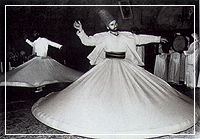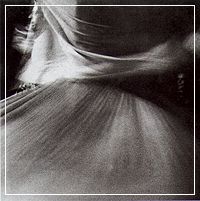 Whirling Dervishes
Whirling Dervishes
 Islamic
mysticism seeks awareness of god in manner being, and hence the various
mystic sects o tarikats of dervishes or sufis have generally been
characterized by open-mindedness, vision, exuberance and lot of the
arts, particularly music and poetry. Their tendency to relegate doctrine
and the outer forms of worship a secondary degree of importance has
frequently brought the sects into conflict with orthodoxy over the
centuries The emphasis on dance
music of the Mevlevi’s, and the transgression of the orthodox
ban on intoxicating liquor by the Bektaşis are issues which were strongly
condemned by the Muslim establishment during Ottoman times in Turkey. Islamic
mysticism seeks awareness of god in manner being, and hence the various
mystic sects o tarikats of dervishes or sufis have generally been
characterized by open-mindedness, vision, exuberance and lot of the
arts, particularly music and poetry. Their tendency to relegate doctrine
and the outer forms of worship a secondary degree of importance has
frequently brought the sects into conflict with orthodoxy over the
centuries The emphasis on dance
music of the Mevlevi’s, and the transgression of the orthodox
ban on intoxicating liquor by the Bektaşis are issues which were strongly
condemned by the Muslim establishment during Ottoman times in Turkey.
The first Islamic sect emerged in Yemen and dates from the 37th
year of the Hegira (657 AD) when the Angel Gabriel is supposed to
have exhorted Üveys el-Karani to turn his back on the material world
and choose a life of asceticism. Each mystic sect by tradition also
asserts legitimacy by tracing its origins to Ali or Ebubekir Cüneyd-I
Bağdadi (died 910) and other sufis forged a link between the concept
of bezm-i elest (the union of God and souls) and the ecstatic dance
known as sema
introducing various recited litanies in praise of God to the accompaniment
of whirling movements. Experts in Muslim jurisprudence have frequently
rejected sects such as the Rufais, Halvetis and Mevlevi’s on
the grounds that dancing degrades religion. In the early 16 th century
, for instance, Ibn Kemal (d. 1534) wrote a treatise entitled Risaletün
fi Tahkik'r-Raks asserting that music and spinning movements
know as devran were sinful, citing early fetva as evidence for his
argument, Ebussuud efendi (d.1574), on the other hand, while still
disapproving, took the view that with certain modifications and restrictions
the practice should be tolerated.
 Many
of the sects which arose in Anatolia, such a Yessevis, Bektaşis and
Nakşis fell foul of orthodox although the Mevlevi’s commanded
the gruding respect of the othodox establishment largely on account
of the Mesnevi, the greatest philosophical work of Mevlana Celaleddin-I
Rumi, a Turkish Sufi who migrated from northern Persia to Anatolia
in the 13th century. The sed which grew up after his death
is by far the most fascinating in terms of dervish culture, including
ritual and costume Many
of the sects which arose in Anatolia, such a Yessevis, Bektaşis and
Nakşis fell foul of orthodox although the Mevlevi’s commanded
the gruding respect of the othodox establishment largely on account
of the Mesnevi, the greatest philosophical work of Mevlana Celaleddin-I
Rumi, a Turkish Sufi who migrated from northern Persia to Anatolia
in the 13th century. The sed which grew up after his death
is by far the most fascinating in terms of dervish culture, including
ritual and costume
The sema of the Mevlevi’s differed from the movement adopted
by other sects. The dervishes turned independently, without touching
shoulder to shoulder, both around their own axis and around the sheikh
and other dervishes. They made neither a sound no any movement of
the hands arms or head The Mevlevi novice underwent long years of
self-denial, penance and training in the sema The state of trans which
the sema induced cut off all awareness apart from that of communion
with God. The Bektaşis, however ridiculed the Mevlevi dance as an
unnecessary adjunct to the worship of God. Mevlana(d. 1273) believed
that the spirit was relieved of the weight of the flesh in the course
of the sema, and that the jubilation which emanated from man2s true
being as sense and thought could only be experienced in this way.
Although the sema could be practiced singly, it was customary for
the dervishes to perform the sema together at noon in the semahane
or hall of dergah. The dervish responsible for the ritual would spread
the sheepskin which symbol ised the office of the sheikh, head of
the convent, on the floor of the semahane. Wearing their white costumes
with voluminous skirts known as tennure and tall hats, the dervishes
would perform their prayers when the sheikh warning a green headdress
appeared. After readings from the Mesnevi and the Koran, one of the
dervishes would begin to play the ney, a reed flute of great antiquity
whose plaintive music is associated almost exclusively to the Mevlevi
sect.
Lord Charlemont, who traveled in Turkey in 1749 gave the following
account of the Mevlevi ceremony, which was performed in public on
Tuesdays and Fridays to an audience which included many women.
 The
crowd pressed toward the extremities of the chamber, which was occupied
by the monks dressed, as usuand in a gown of coarse whitish cloth,
close before and behind, and fastened about the was it with a leather
strap. Over this they wore a sort of jacket… On their heads
they wore caps of the same color, usually made or camel's hair,
and stiffened into the form of sugar-loaf (The prayer) was succeeded
by a long hymn, performed with great vociferation, and to our prejudiced
ears, with little music, and accompanied by a sort of flute or baut
bois and by a large tabor like a small kettle-drum. As soon as the
hymn was ended, the instruments changed their tune into something
of a quicker movement, and the monks began to turn themselves round
with a velocity not to be described or easily conceived. Our most
fixed attention could not count the number of their revocations,
but according to our best reckoning, they must have exceeded sixty
in one minute. This painful exercise was continued for a considerable
time, till at length the music ceased, and they stopped seemingly
undisturbed by giddiness, and thus the ceremony ended. The
crowd pressed toward the extremities of the chamber, which was occupied
by the monks dressed, as usuand in a gown of coarse whitish cloth,
close before and behind, and fastened about the was it with a leather
strap. Over this they wore a sort of jacket… On their heads
they wore caps of the same color, usually made or camel's hair,
and stiffened into the form of sugar-loaf (The prayer) was succeeded
by a long hymn, performed with great vociferation, and to our prejudiced
ears, with little music, and accompanied by a sort of flute or baut
bois and by a large tabor like a small kettle-drum. As soon as the
hymn was ended, the instruments changed their tune into something
of a quicker movement, and the monks began to turn themselves round
with a velocity not to be described or easily conceived. Our most
fixed attention could not count the number of their revocations,
but according to our best reckoning, they must have exceeded sixty
in one minute. This painful exercise was continued for a considerable
time, till at length the music ceased, and they stopped seemingly
undisturbed by giddiness, and thus the ceremony ended.
Galata Mevlevihane, the dervish convent visited by Charlemont, was
one of Istanbul’s most distinguished centers of music and literature
until the turn of the 20th century. Many major Turkish
composers, calligraphers and poets trained here. Foremost among them
was the scholar and poet Şeyh Galip (1757-1799), who under the patronage
of Sultan Selim III and his sister Beyhan Sultan became şeyh of the
dergah.
 The
Mevlevi dervishes had lodges in many parts of Turkey, including Afyon,
Kütahya, Bursa, Gelibolu, Aleppo, and of
course Konya the home of Mevlana. In İstanbul
there were Mevlevi lodges at Kulekapısı, Bahariye in Beşiktaş, Kasımpaşa
and Üsküdar. They all consisted of a large inner courtyard surrounded
by the semahane, a room for the novices, reception rooms, a harem
where the family of the sheikh lived, refectory, and kitchen. Day
began with morning prayers and meditation, and continued with study
of Mevlana's writings, and then music practice on the ney and kudüm,
a small double drum played with small sticks. Although Charlemont
referred to the dervishes as monks, the resemblance is only slight,
since dervishes married, kept their own homes, and made their own
livings. The
Mevlevi dervishes had lodges in many parts of Turkey, including Afyon,
Kütahya, Bursa, Gelibolu, Aleppo, and of
course Konya the home of Mevlana. In İstanbul
there were Mevlevi lodges at Kulekapısı, Bahariye in Beşiktaş, Kasımpaşa
and Üsküdar. They all consisted of a large inner courtyard surrounded
by the semahane, a room for the novices, reception rooms, a harem
where the family of the sheikh lived, refectory, and kitchen. Day
began with morning prayers and meditation, and continued with study
of Mevlana's writings, and then music practice on the ney and kudüm,
a small double drum played with small sticks. Although Charlemont
referred to the dervishes as monks, the resemblance is only slight,
since dervishes married, kept their own homes, and made their own
livings.
- See also:
-
Photos
of Whirling Dervishes and
Photos
of Sema dancing in Hacibektas
|